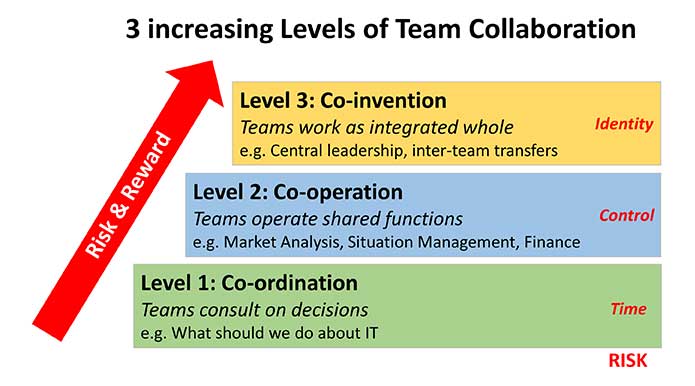Many of our simulations provide teams with opportunities to collaborate and/or compete.
For example, in the XSIM Simulation you compete to be the best business unit whilst collaborating to work with your colleagues in the other business units for the common good.

In the COMPETE simulation you compete with the other businesses for market share but you can also collaborate with your competitors to grow the market for everyone’s benefit.
There are many blends of collaboration/competition – the diagram at the top of the page shows the 4 most common types (these are described in much more detail here).
Collaboration itself can also take many forms and when individuals or teams talk about ‘collaborating’ they are all probably all talking about something different and therefore they are unlikely to reach any meaningful agreement.
We have found it useful to think about 3 progressive “levels” of collaboration – each level very different from the other and summarised in the diagram below:
• Co-invention
• Co-operation
• Co-ordination

LEVEL 1 - Collaboration as …. Co-ordination
At the lowest level of collaboration we have Co-ordination such as teams consulting on common problems. The risk is low with the biggest downside being you have wasted your time. Likewise the reward is also low.
LEVEL 2 - Collaboration as …. Co-operation
At the middle level of collaboration we have Co-operation such as teams agreeing to operate a shared function for a common job or issue. The risk is medium with the downside being a loss of control. Likewise the reward is also medium with efficiency savings around duplication of effort.
LEVEL 3 - Collaboration as …. Co-invention
At the highest level of collaboration we have Co-invention such as teams agreeing to operate as an integrated whole with a common leadership and decisions structure.. The risk is high with the downside being a loss of identity as you and your objectives become subsumed into and subservient to a greater whole. Likewise the reward is also high with huge efficiencies around optimizing the deployment of resources for the greater good.
Conclusions
Business Simulations can be a great vehicle for understanding the blending of collaboration and competition in organizations and the different levels of collaboration which might be appropriate to different situations.